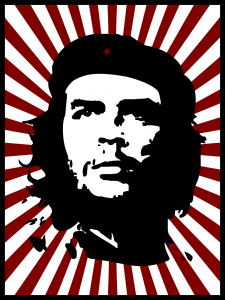The Iconic Che Guevara T-Shirt
Introduction
In 1960, Alberto Korda captured a photograph of Ernesto “Che” Guevara that would turn out to be one of the most reproduced and well-known images of all time. Korda took the picture of the Argentinian Marxist revolutionary at a critical moment in Cuban history just before the Cuban Revolution. While the photo was not immediately popular, years later it would find a way to spread like wildfire.
Che Guevara
Che Guevara’s journey into the icon he is today began while he was a medical student traveling through South America. On his travels, he saw disease, hunger, and poverty, and blamed the capitalist United States of America for these issues. This sparked within him an intense fire to overturn and reform countries that he believed the United States had affected negatively. He turned to guerrilla tactics to do such and, over time, rose widely to fame during the Cuban Revolution.
Guevara was thought by many to be incredibly charismatic with great personal magnetism. However, within this enchanting persona also dwelled a cold, harsh, and violent activist who believed that the United States should be destroyed. The last article he wrote in 1967 was entitled “Create Two, Three, Many Vietnams” and called for “…the people’s unity against the great enemy of mankind: the United States of America.”
The Image & Aftermath
The iconic Che Guevara image, seen on millions of t-shirts, posters, key chains, hats, flags, and in many pop culture references today, was taken at a funeral for 136 people who had been killed in an explosion off of Havana harbor. At the funeral, Fidel Castro placed blame on the United States for the incident, which would soon after lead to the start of the Cuban Revolution.
Guevara was on stage with Castro and other leaders, but Korda later recounted that he was not very visible during the ceremony. For just a few moments, however, he came into the frame, and Alberto Korda captured a stoic, fierce, determined, angry, and fearless Guevara staring into the distance and contemplating the situation at hand (for more info on the photographer of this famed photo, check out this site).
The use of the image did not occur immediately, as the focus was on Castro and other leaders. In 1967, after Guevara was eventually captured and executed during guerrilla warfare in Bolivia, Korda’s photo suddenly became popular. Demonstrations condemning the “murder” of Che occurred worldwide, and protestors began using the image. The photograph came to be known as “Guerrillero Heroico,” on posters, billboards, and in other printed materials. The Cuban government hung a five-story version on a building in Havana as Castro addressed a rally.
Soon after his death, Giangiacomo Feltrinelli published Che’s diary from his time in Bolivia. Feltrinelli, an Italian publisher, had gained the rights to the image from Korda before Guevara’s death. Feltrinelli used the iconic photo for the book cover. The image continued to take off, being reproduced worldwide on political posters celebrating the Cuban Revolution.
The Image Now
Over the years, Korda’s photograph of the fearless revolutionary has been reproduced time and time again. By the 21st century, many who have seen the image no longer know the facts behind the photo and the man. Guevara’s face has become an icon, adorning shirts, sweaters, mugs, sneakers, flasks, and other items. In an ironic twist, Guevara’s image became a staple of the capitalist commercialism that Guevara wanted to destroy.
Not only has the full image itself been reproduced, but also smaller and slightly altered photographs of the image have been used time and time again in advertisements and art. Head shots of many famous individuals—from Madonna, to Princess Diana, to Jesus Christ—have been photoshopped and made to look like Che. Converse sneakers, Taco Bell, and Smirnoff Vodka have used the likeness for advertisements.
Conclusion
Korda’s Che Guevara photograph has lost its original meaning, over time, due to commercial dilution. Many believe that the photograph demonstrates Che’s intensity and strength, implying someone who is a deep thinker and visionary. The 1960s Che Guevara was known and understood as a violent, sociopathic revolutionary. However, the iconic Che Guevara of the 21st century has come to symbolize nonconformity, radicalism, and a desire for change. He has been de-politicized and re-shaped into a more benign symbol of civil disobedience and dissent.



